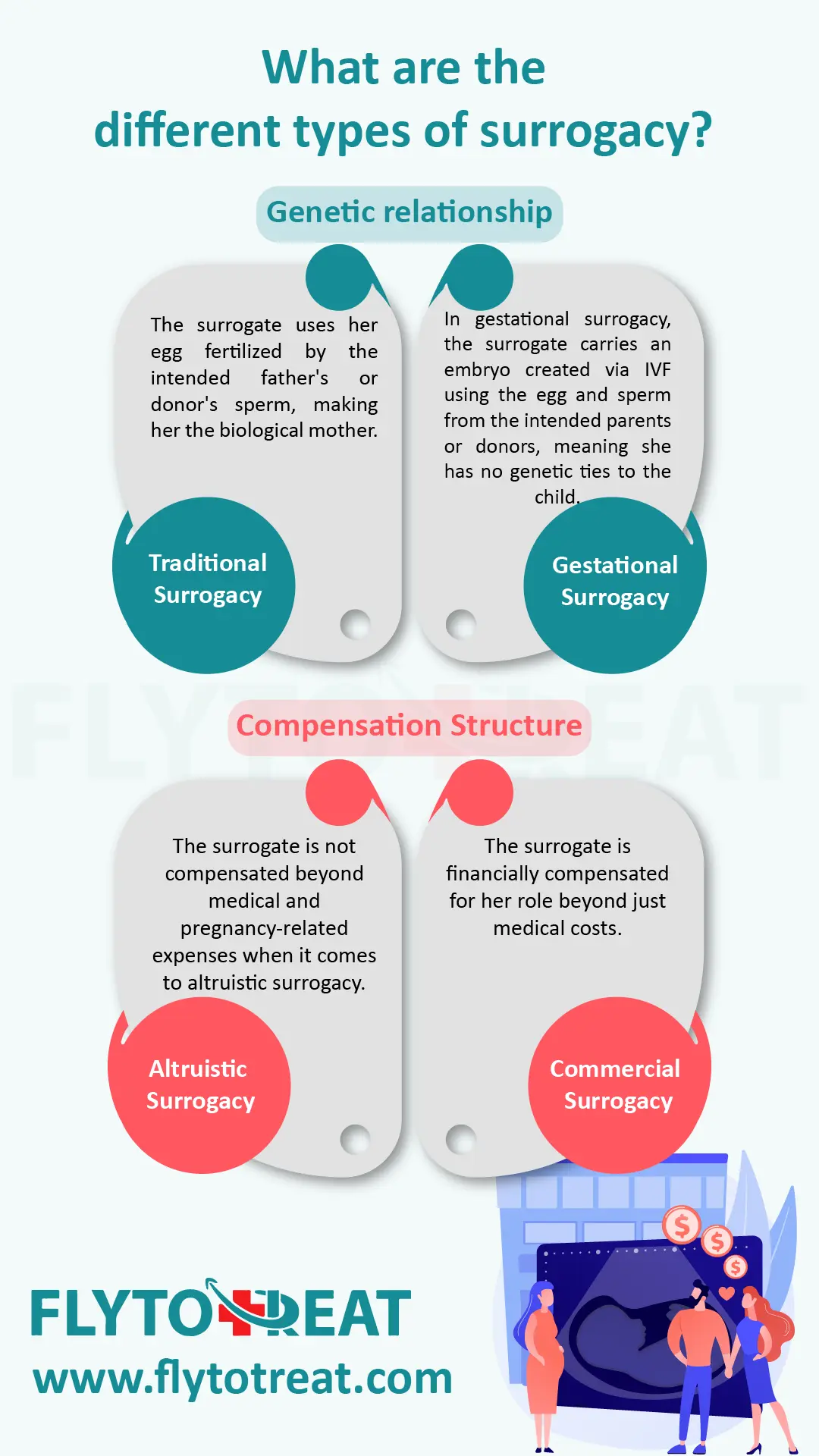
Surrogacy vs Gestational Carrier
Understanding surrogacy types is essential for anyone considering this pathway to parenthood. FlyToTreat offers detailed insights into the different surrogacy arrangements, answering crucial questions like "What are the four types of surrogacy?", "What is the meaning of surrogate type?" and "What is the difference between TS and GS surrogacy?" This article will assist you in understanding the complexities of traditional and gestational surrogacy, ensuring you make informed decisions.
What is 4 types of surrogacy? (surrogacy types)
There are 4 types of surrogacy for carrying a pregnancy and two categorizations for surrogacy types. We can name the first categorization a genetic relationship and the second a compensation structure. Here is a breakdown:
Genetic relationship:
• Traditional Surrogacy: The surrogate uses her egg fertilized by the intended father's or donor's sperm, making her the biological mother.
• Gestational Surrogacy: In gestational surrogacy, the surrogate carries an embryo created via IVF using the egg and sperm from the intended parents or donors, meaning she has no genetic ties to the child.
Compensation Structure:
• Altruistic Surrogacy: The surrogate is not compensated beyond medical and pregnancy-related expenses when it comes to altruistic surrogacy.
• Commercial Surrogacy: The surrogate is financially compensated for her role beyond just medical costs.
These types of surrogacy help accommodate various needs and preferences of intended parents.
Important note: Some may ask, "What is the difference between TS and GS surrogacy?" These abbreviations stand for traditional and gestational surrogacy. If you need detailed information and a roadmap for surrogacy, Flytotraet can assist you with professional consultancy. Feel free to book a free consultation.

What is gestational surrogacy?
Gestational surrogacy is a form of surrogacy that allows intended parents to have a biological child through IVF (in vitro fertilization). Here's how it works:
• Egg & Sperm Source: Intended parents (or a donor) provide the eggs and sperm used to create an embryo.
• Implantation: The embryo is implanted in the gestational carrier's uterus, which has no genetic link to the baby.
• Pregnancy & Delivery: The gestational carrier carries the pregnancy and delivers the baby to the intended parents.
Key Distinction: Unlike traditional surrogacy, the gestational carrier does not use her own eggs. This allows intended parents with fertility challenges or medical conditions to experience parenthood.
How does a woman get pregnant with surrogacy?
In the surrogacy process, a woman becomes pregnant through medical procedures rather than traditional conception:
• Pregnancy with Traditional Surrogacy: The surrogate's egg is fertilized by the intended father's or a donor's sperm via artificial insemination. This process makes the surrogate the biological mother.
• Pregnancy with Gestational Surrogacy: The surrogate carries an embryo created using in vitro fertilization (IVF). The embryo is made from the intended parents' or donors' egg and sperm, so the surrogate has no genetic link to the child. The surrogate's uterus is where the embryo is implanted, and she carries the pregnancy to full term.
These methods are part of the various surrogacy types, addressing different surrogacy vs gestational carrier needs. This process is highly regulated and involves comprehensive medical and legal protocols to ensure the safety and rights of all parties involved.
Does a surrogate baby have the mother's DNA?
A baby born through gestational surrogacy does not share DNA with the surrogate mother. The embryo is created using the egg and sperm from the intended parents or donors, meaning the genetic material comes from them, not the surrogate. The surrogate's role is to carry the pregnancy, but she has no genetic connection to the child. This distinction is a crucial factor differentiating gestational surrogacy from traditional surrogacy, where the surrogate's egg is used, and she shares DNA with the baby.
Is the surrogate mother the biological mother?
The surrogate mother is not the biological mother in gestational surrogacy. The embryo is created using the egg and sperm from the intended parents or donors, meaning the surrogate carries the pregnancy. Still, it has no genetic connection to the child. This is different from traditional surrogacy, where the surrogate's egg is used, making her both the biological and gestational mother. Understanding these distinctions is crucial when exploring the various types of surrogacy and their implications.
What is the meaning of surrogate type?
The term "surrogate type" refers to the different methods of surrogacy arrangements, which are primarily divided into two main categories: traditional surrogacy and gestational surrogacy. In traditional surrogacy, the surrogate mother uses her egg, making her the biological mother of the child. The egg is fertilized by sperm from the intended father or a donor. In gestational surrogacy, the surrogate carries an embryo created via IVF using the egg and sperm from the intended parents or donors, meaning she has no genetic ties to the child.
These surrogacy types help define the roles and responsibilities in the surrogacy process, influencing legal, ethical, and emotional considerations.
How does surrogacy work
Surrogacy offers intended parents the chance to build a family. It can be a complex process, but here's a simplified breakdown:
• What is the Matching & Screening Step? Intended parents connect with a surrogate (or gestational carrier) through agencies or platforms. Both parties undergo medical, psychological, and legal evaluations.
• How is the IVF Process for surrogacy? As mentioned, Intended parents (or donors) provide eggs and sperm. In vitro fertilization (IVF) is used to bring embryos to life. You can learn
• What is the Embryo Transfer step in surrogacy? The healthy embryo is then transferred to the surrogate's uterus via a catheter.
• How will Pregnancy & Delivery take place in surrogacy? The surrogate carries the pregnancy and delivers the baby to the intended parents.
• What about surrogacy Legal Agreements? Legal contracts are established beforehand outlining parental rights and responsibilities.
Surrogacy laws vary by region. It's crucial to involve an experienced attorney specializing in surrogacy to ensure a smooth legal experience.
How Common is Gestational Surrogacy?
Gestational surrogacy is an increasingly popular option for couples facing infertility. Each year, thousands of babies are born through gestational surrogacy in the United States. An estimated 20,000 children are born each year around the world and According to Forbes, the commercial surrogacy industry is expected to grow tenfold by 2032, driven by increasing demand not only from celebrities but from a broadening demographic globally.
Here are some key points:
• Prevalence: The number of births via gestational surrogacy has grown significantly, partly due to the medical and legal advantages it offers over traditional surrogacy.
• Legal Support: Many states in the U.S. have established clear legal frameworks that support and regulate gestational surrogacy, ensuring the rights of all parties involved.
• Medical Advances: Improved techniques in in vitro fertilization (IVF) have increased the success rates of gestational surrogacy, making it a more viable option for intended parents.
• Global Perspective: While prevalent in the U.S., gestational surrogacy is also growing in popularity worldwide as awareness and acceptance increase.
This comprehensive support makes gestational surrogacy a reliable and increasingly common method for family building.
surrogacy vs gestational carrier
The terms "surrogacy" and "gestational carrier" are often confused, but they refer to different methods. In traditional surrogacy, the surrogate mother uses her own egg fertilized by the intended father's or donor's sperm, making her the biological mother. This method can carry more emotional and legal complexities due to the genetic link.
On the other hand, a gestational carrier has no biological connection to the child. In this gestational surrogacy process, an embryo created through IVF using the intended parents' or donors' egg and sperm is implanted in the carrier's womb. This method is often preferred due to fewer legal risks and more explicit parental rights.
Understanding these surrogacy types helps in choosing the right path for family building. While traditional surrogacy can pose emotional challenges, gestational surrogacy is widely considered more straightforward, legally and emotionally. This distinction is crucial in the surrogacy process, offering clearer guidelines for intended parents.
Whose egg is used in surrogacy
In surrogacy, the type of surrogacy determines whose egg is used.
• Where does the egg come from in traditional surrogacy? The surrogate mother uses her own egg, fertilized by the intended father's or a donor's sperm through artificial insemination. This makes her the biological mother of the baby.
• From where does the egg come from in Gestational Surrogacy? The surrogate (gestational carrier) has no genetic connection to the child. Instead, the egg comes from the intended mother or an egg donor, and fertilization occurs via IVF before the embryo is implanted in the surrogate.
These surrogacy types offer different approaches, with gestational surrogacy being more common due to clearer legal and emotional boundaries.
Understanding the distinction between surrogacy vs gestational carrier is crucial for intended parents navigating the surrogacy process.
What is full surrogacy and partial surrogacy?
Full surrogacy and partial surrogacy represent two distinct surrogacy types.
• Full surrogacy, also known as gestational surrogacy, involves the surrogate carrying an embryo created using the egg and sperm of the intended parents or donors, meaning the surrogate has no genetic connection to the baby. This process typically utilizes IVF to implant the embryo into the surrogate's uterus.
• Partial surrogacy, also known as traditional surrogacy, involves the surrogate's own egg being fertilized by the sperm of the intended father or a donor, making the surrogate the biological mother of the child. This method is often facilitated through artificial insemination.
These surrogacy types differ significantly in terms of genetic relationships and legal considerations, influencing the overall surrogacy process. Understanding the differences between gestational surrogacy and traditional surrogacy is crucial for intended parents when making informed decisions about their surrogacy journey. Both methods have their unique complexities and requirements that must be carefully considered.
conclusion
To wrap up, exploring the various surrogacy types is crucial for intended parents. FlyToTreat provides comprehensive information on both traditional and gestational surrogacy, including the legal, ethical, and emotional considerations of each. By understanding the differences and implications, such as the genetic links and compensation structures, you can make well-informed decisions about your surrogacy journey. Whether you opt for traditional or gestational surrogacy, this knowledge will guide you through the process smoothly.
MEDICALLY REVIEWED BY: Dr. Ali Bazazi
AUTHOR: FlytoTreat's team of Authors
14 July 2024 - Updated At: 01 February 2025
Related Articles
Comment





